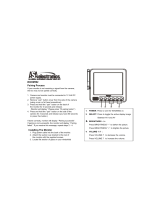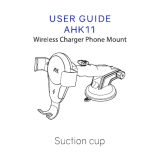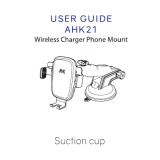
Table of Contents
Getting Started............................................................... 1
Mounting Your Device in a Motorcycle....................................... 1
About the Powered Mount Cables......................................... 1
Installing the Handlebar Base................................................ 1
Attaching the Power Cables to the Motorcycle Mount........... 1
Attaching the Base Plate to the Motorcycle Mount................ 2
Attaching the Base Plate to the Handlebar Base.................. 2
Installing Your Device in the Motorcycle Mount..................... 2
Removing Your Device from the Motorcycle Mount................... 2
Mounting Your Device in an Automobile.................................... 2
Support and Updates................................................................. 3
Setting Up Garmin Express................................................... 3
nüMaps Guarantee™............................................................ 3
About nüMaps Lifetime™...................................................... 3
Entering and Exiting Sleep Mode............................................... 3
Turning Off the Device............................................................... 3
Resetting the Device............................................................. 3
Adjusting the Screen Brightness................................................ 3
Adjusting the Volume................................................................. 3
Status Bar Icons......................................................................... 3
Acquiring GPS Signals.......................................................... 3
Transportation Modes............................................................ 3
Battery Information................................................................ 3
Setting the Time.................................................................... 3
Using the On-Screen Buttons..................................................... 4
Using the On-Screen Keyboard................................................. 4
About Shortcuts.......................................................................... 4
Adding a Shortcut.................................................................. 4
Removing a Shortcut............................................................. 4
Finding Locations.......................................................... 4
Locations.................................................................................... 4
Finding a Location by Category............................................. 4
Finding a Location Using the Search Bar.............................. 4
Changing the Search Area.................................................... 4
Reporting a Closed or Missing Location................................ 4
Editing Location Information.................................................. 4
Rating a Point of Interest....................................................... 5
Search Tools.............................................................................. 5
Finding an Address................................................................ 5
Finding an Intersection.......................................................... 5
Finding a City......................................................................... 5
Finding a Location Using Coordinates................................... 5
Finding a Location by Browsing the Map............................... 5
Saving a Home Location............................................................ 5
Going Home.......................................................................... 5
Editing Your Home Location Information............................... 5
Finding Recently Found Destinations......................................... 5
Clearing the List of Recently Found Locations...................... 5
Finding Parking.......................................................................... 5
Setting a Simulated Location...................................................... 5
Saving Locations........................................................................ 5
Saving a Location.................................................................. 5
Saving Your Current Location............................................... 5
Starting a Route to a Saved Location.................................... 6
Editing a Saved Location....................................................... 6
Assigning Categories to a Saved Location............................ 6
Sharing a Saved Location..................................................... 6
Sending a Location to the Device.......................................... 6
Deleting a Saved Location..................................................... 6
Navigation....................................................................... 6
Starting a Route......................................................................... 6
Changing the Route Calculation Mode.................................. 6
Previewing Multiple Routes................................................... 6
Starting a Route to a Saved Location
.................................... 6
Taking a Route Using Curvy Roads...................................... 6
Your Route on the Map.............................................................. 6
Using the Navigation Map..................................................... 7
Adding a Point to a Route...................................................... 7
Skipping a Point in Your Route.............................................. 7
Taking a Detour..................................................................... 7
Stopping the Route................................................................ 7
Using Suggested Routes....................................................... 7
About Exit Services.................................................................... 7
Finding Exit Services............................................................. 7
Navigating to an Exit.............................................................. 7
Avoiding Road Features............................................................. 7
About Custom Avoidances......................................................... 7
Avoiding an Area................................................................... 7
Avoiding a Road.................................................................... 7
Disabling a Custom Avoidance.............................................. 7
Deleting Custom Avoidances................................................ 7
Enabling Advanced Detours....................................................... 8
Taking a Detour Around Specified Areas.............................. 8
Navigating Off Road................................................................... 8
Enabling Fuel Tracking............................................................... 8
Setting a Low Fuel Warning.................................................. 8
Map Pages...................................................................... 8
Customizing the Map.................................................................. 8
Customizing the Map Layers................................................. 8
Viewing the Trip Log.............................................................. 8
Changing the Map Data Field................................................ 8
Customizing Map Buttons...................................................... 8
Changing the Map Dashboard............................................... 8
Changing the Map Perspective............................................. 8
Viewing Route Activity................................................................ 8
Viewing a List of Turns.......................................................... 8
Viewing the Next Turn........................................................... 8
Viewing Junctions.................................................................. 8
Viewing Traffic Alerts............................................................. 9
Viewing Trip Information........................................................ 9
Viewing Current Location Information........................................ 9
Finding Nearby Services....................................................... 9
Getting Directions to Your Current Location.......................... 9
Hands-Free Features..................................................... 9
Enabling Bluetooth Wireless Technology................................... 9
About Wireless Headsets........................................................... 9
Pairing a Wireless Headset................................................... 9
About Hands-Free Calling.......................................................... 9
Pairing Your Phone............................................................... 9
Placing a Call......................................................................... 9
Receiving a Call................................................................... 10
Using the Call History.......................................................... 10
Using In-Call Options........................................................... 10
Saving a Home Phone Number........................................... 10
Disconnecting a Bluetooth Device............................................ 10
Deleting a Paired Bluetooth Device.......................................... 10
Using the Apps............................................................. 10
Using Help................................................................................ 10
Searching Help Topics........................................................ 10
Planning a Trip......................................................................... 10
Scheduling a Trip................................................................. 10
Changing Transportation Modes in a Trip........................... 10
Navigating to a Saved Trip.................................................. 10
Editing a Saved Trip............................................................ 10
TracBack®................................................................................10
Following Your Recent Track.............................................. 10
Saving Your Recent Track as a Trip.................................... 11
Tire Pressure............................................................................ 11
Table of Contents i
























